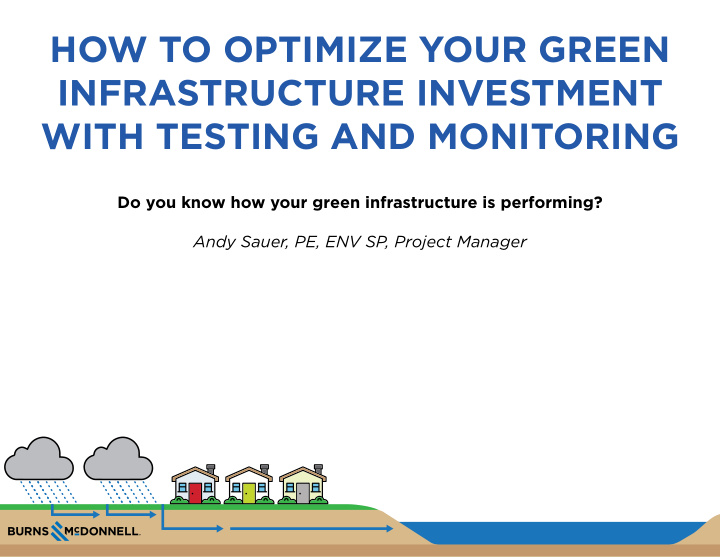



HOW TO OPTIMIZE YOUR GREEN INFRASTRUCTURE INVESTMENT WITH TESTING AND MONITORING Do you know how your green infrastructure is performing? Andy Sauer, PE, ENV SP, Project Manager
GREEN INFRASTRUCTURE Sometimes referred to as stormwater best management practices (BMP), green infrastructure are dynamic systems that use natural features like soils and vegetation to manage stormwater and are often used for: • Water quality regulatory compliance • Enhancing open spaces • Creating more resilient urban development To avoid costly maintenance, invasive weeds and poor performance — begin optimizing green infrastructure by knowing: • What distinguishes good from bad design • What vegetative bioretention cells are and how they work • Testing and monitoring techniques • Benefjts of adaptive design
GREEN INFRASTRUCTURE DESIGN DONE RIGHT Good design • Optimizes soil infjltration rates and plant performance • Enables adaptations after construction to meet actual conditions • Reduces maintenance costs over time • Improves performance over time • Allows monitoring and testing throughout the life of the design Poor design • Doesn’t retain enough water for plant life • Requires multiple replantings • More expensive over time • Reduces performance over time
VEGETATIVE BIORETENTION CELLS To best incorporate green infrastructure, vegetative bioretention cells are an efgective design technique: • Bioretention cells allow for largest stormwater capture in a small footprint • Engineered soils within bioretention cells allow for enhanced design control more than natural systems, such as rain gardens
BIORETENTION CELL MONITORING Soil profile analysis indicates moisture levels in root zones as vegetation becomes established. Flow monitoring and precipitation gauges indicate stormwater runofg volume and infmow/outfmow rates. Infiltration monitoring using the ponding method indicates infjltration rates and water-holding times.
WHAT’S IN A SOIL PROFILE? • Soil moisture • Soil temperature • Infjltration rates
WHAT’S INVOLVED WITH FLOW MONITORING AND PRECIPITATION GAUGES? Flow in and out • Confjrm design fmow rates • Calculate volume of water retained On-site precipitation monitoring • Monitor site-specifjc rain events • Calculate runofg volume captured by bioretention cell
WHAT’S INVOLVED WITH INFILTRATION MONITORING? Ponding (water level) monitoring • Understand real rainfall event ponding depth with time • Calculate infjltration rates • Understand holding times for specifjc events • Utilize to adjust outfmow for optimal retention and plant performance Traditional method — Infiltrometer • Infjltration rate
BIORETENTION TESTING Soil moisture • Understand moisture levels at difgerent soil depths • Used over time as soil moisture profjles change • Regulate stormwater discharge to maximize plant performance Methods: • Soil moisture sensors • Neutron probe • Tensiometers
APPLYING ADAPTIVE DESIGN Optimize green infrastructure performance • Improved plant performance • Match water retention times to maximize soil moisture storage • Maximize soil infjltration and plant evapotranspiration Improve future green infrastructure design • Inform owner of the right soil mix for location • Update design standards to include better soil specifjcation
Andy Sauer, PE, ENV SP Project Manager 816-448-7578 linkedin.com/in/andysauer Andy Sauer is a project manager/green infrastructure and stormwater leader with Burns & McDonnell. As a senior water resources engineer, Andy has more than 10 years of experience in urban wet weather issues. Andy currently serves on the national Water Environmental Federation (WEF) Community of Practice on Sustainability. He earned a bachelor’s degree in agricultural engineering and a master’s degree in agricultural and biological systems engineering from the University of Nebraska-Lincoln.
Recommend
More recommend